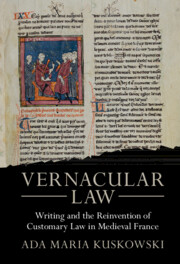Book contents
- Vernacular Law
- Studies In Legal History
- Vernacular Law
- Copyright page
- Dedication
- Contents
- Figures
- Acknowledgments
- A Note on the Text
- Introduction Vernacular Writing and the Transformation of Customary Law in Medieval France
- Part I Written Custom and the Formation of Vernacular Law
- Part II Political and Intellectual Tensions
- Part III Implications
- Conclusion Lasting Model and Professional Community
- Bibliography
- Index
Conclusion - Lasting Model and Professional Community
Published online by Cambridge University Press: 27 October 2022
- Vernacular Law
- Studies In Legal History
- Vernacular Law
- Copyright page
- Dedication
- Contents
- Figures
- Acknowledgments
- A Note on the Text
- Introduction Vernacular Writing and the Transformation of Customary Law in Medieval France
- Part I Written Custom and the Formation of Vernacular Law
- Part II Political and Intellectual Tensions
- Part III Implications
- Conclusion Lasting Model and Professional Community
- Bibliography
- Index
Summary
The thirteenth-century coutumiers capture a moment of intellectual ebullience. They were part of the formative moments of the lay courts and the theorization of ‘law in practice’ and in this sense the coutumiers were the linchpin of French legal thinking until the Revolution – and beyond in some French colonies. They created something powerful in the French legal imagination, so powerful that their use only increased with time and eventually became official law when the kings demanded coutumiers to be written for all the regions of France in the fifteenth and sixteenth centuries. This was all due to the ingenuity and intellectual creativity of the thirteenth-century lay jurists who borrowed, constructed, and effectively created a field of knowledge known as ‘customary law’.
Keywords
- Type
- Chapter
- Information
- Vernacular LawWriting and the Reinvention of Customary Law in Medieval France, pp. 348 - 362Publisher: Cambridge University PressPrint publication year: 2022

